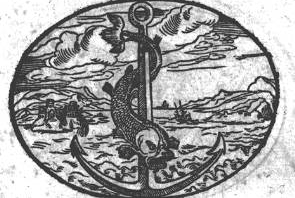Chap. II.
Of the Picture of Dolphins.
THAT Dolphins are crooked, is not only affirmed by the hand of the Painter, but commonly conceived their natural and proper figure; which is not only the opinion of our times, but seems the belief of elder times before us. For beside the expressions of Ovid and Pliny, their Pourtraicts in some ancient Coyns are framed in this figure, as will appear in some thereof in Gesner, others in Goltsius, and Lævinus Hulsius in his description of Coyns, from Julius Cæsar unto Rhodulphus the Second.[1]
Notwithstanding, to speak strictly in their natural figure they are streight, nor have their spine convexed, or more considerably embowed, then Sharks, Porposes,[2] Whales, and other Cetaceous animalls, as Scaliger plainly affirmeth; Corpus habet non magis curvum quam reliqui pisces. As ocular enquiry informeth; and as unto such as have not had the opportunity to behold them, their proper pourtraicts will discover in Rondeletius, Gesner, and Aldrovandus. And as indeed is deducible from pictures themselves; for though they be drawn repandous, or convexedly crooked in one piece, yet the Dolphin that carrieth Arion is concavously inverted, and hath its spine depressed in another. And answerably hereto may we behold them differently bowed in medalls, and the Dolphins of Tarus and Fulius do make another flexure from that of Commodus and Agrippa.
And therefore what is delivered of their incurvity, must either be taken Emphatically, that is, not really but in appearance; which happeneth, when they leap above water, and suddenly shoot down again; which is a fallacy in vision, whereby straight bodies in a sudden motion protruded obliquely downward, appear unto the eye crooked; and this is the construction of Bellonius. Or if it be taken really, it must not universally and perpetually; that is, not when they swim and remain in their proper figures, but only when they leap, or impetuously whirl their bodies any way; and this is the opinion of Gesnerus. Or lastly, It may be taken neither really nor emphatically, but only Emblematically: for being the Hieroglyphick of celerity, and swifter than other animals, men best expressed their velocity by incurvity, and under some figure of a bow: and in this sense probably do Heralds also receive it, when from a Dolphin extended, they distinguish a Dolphin embowed.
And thus also must that picture be taken of a Dolphin clasping an Anchor: that is, not really, as is by most conceived out of affection unto man, conveighing the Anchor unto the ground: but emblematically, according as Pierius hath expressed it, The swiftest animal conjoyned with that heavy body, implying that common moral, Festina lentè: and that celerity should always be contempered with cunctation.[3]
NOTES
* [My or others' notes are in square brackets]; Browne's marginalia is unmarked; {passages or notes from unpublished material by Browne is in curly braces}. Ross dismisses this chapter in Arcana Microcosmi II.11.i, saying that the dolphin is sometimes straight, sometimes crooked.
1 [Adolphus]
2 [Wren: Reade porkpisces. The porkpisce (that is the dolphin) hath his name from the hog hee resembles in convexity and curvitye of his backe, from the head to the tayle: nor is hee otherwise curbe, then as a hog is: except that before a storme, hee tumbles just as a hog runs. That which I once saw, cutt up in Fish street, was of this forme and above five foote longe: his skin not skaly, but smoothe and black, like bacon in the chimney: and his bowels in all points like a hog: and yf instead of his foure fins you imagine four feete, hee would represent a black hog (as it were) sweal'd alive.
The dolphin and the porpoise are separate beings. However, according to Wilkin, "Ray says that the porpoise is the dolphin of the ancients", as coins would seem to indicate. "The following passage from Philosophical Letters... corroborates the dean's proposed etymology. It occurs in a letter to Dr. Martin Lister, May 7, 1669. 'Totam corpus copiosâ et densâ pinguedine (piscatores blubber vocant) duorum plus minus digitorum crassitie undique integebatur, immediate sub cute, et supra carnem musculosam sita, ut in porcis; ob quam rationem, et quod porcorum grunnitum quadentenus imitetur, porpesse — i. e. porcum piscem, dictum cm existimo.'"]
3 [Note, pace his critics, that Browne is well aware of his prose style and tendency to latinisms, and also has a good sense of humor. Dolphin and anchor: as discussed at length by Erasmus, on a coin attributed to Augustus (or, occasionally, to Titus). It was the device of the Manutius family of printing fame; hence variations occur in printers' devices:
 .]
.]
This page is dedicated to the memory of Boo the Cat.
